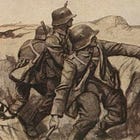The Origin of the Term "Stosstrupp"
The German Army of World War I
Every now and then, The Tactical Notebook will pull an old article out the attic, knock the cobwebs off of it, and share it with present-day subscribers. This piece, originally published in December of 2022, is one such post.
In 1915, a German reserve officer, Captain Bernhard Reddemann, coined the term Stosstrupp. Reddemann, a former firefighter who led of the first unit of the German Army to be exclusively concerned with the employment of portable flamethrowers, used the term to designate a small team armed with two such weapons. The word Stoss - referring to a thrust, like that of a fencer - emphasized the definitive task of such units, which were charged with pushing into the depth of enemy positions in order to strike targets of particular importance.
Later in 1915, Captain Willy Martin Rohr, the commander of the first assault detachment (Sturmabteilung) of the German Army, applied to the term Stosstrupp to teams of men armed with hand-grenades and other close-combat weapons. Like Reddemann’s flamethrower teams, Rohr’s Stosstrupps thrust deep into French, British, and Belgian positions in order to knock out machine gun nests and centers of resistance. In the course of World War I, many German soldiers imitated the equipment, technique, and nomenclature of Rohr’s Stosstrupps. Thus, by the end of the war, thousands of units, some as small as eight-man squads and others as large as thirty-man platoons, proudly bore the moniker of Stosstrupps.
Between 1919 and 1923, the Freikorps (volunteer formations that fought in Poland, the Baltic, and many parts of Germany) used the term Stosstrupp to describe units of company size that, in addition to close combat weapons, were well supplied with machine guns, trench mortars, and light field pieces. In the same period, the National Socialist Party gave the title of Stosstrupp Adolf Hitler to the brown-shirted bully brigade that would later evolve into the infamous Sturmabteilung (S.A.)
During the Second World War, Bernard Reddemann, who had become the fire chief of Leipzig, used the term Stosstrupp to designate units that played a central role in his system of firefighting tactics. Rather than pouring water around the edges of a fire, the men of these units moved rapidly into the depth of a blaze into order to combat its ‘center of gravity’ (Schwerpunkt.)
Note: While the word Trupp (plural Trupps) generally described a squad, platoon, or (less often) company, the word Truppe (plural Truppen) could refer to a unit of just about any size, as well as to the soldiers who serve in such an organization. Thus, while every Stosstrupp might be described as a Stosstruppe, the reverse was not necessarily true.
For Further Reading:
To Share, Subscribe, or Support:






Reddemann’s WW1 battles had a lot more to do with development of Sturm tactics than he gets credit for in history.
“German Flamethrower Pioneers of World War I” by Thomas Wictor. Excellent book, I have it.
A full review would be Enlightening to all ...
aka FireFighter Reddemann